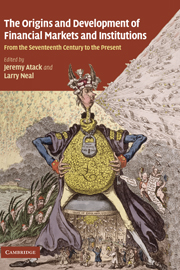 The Origins and Development of Financial Markets and Institutions
The Origins and Development of Financial Markets and Institutions Published online by Cambridge University Press: 04 August 2010
Liam Brunt, the author of a recent and otherwise admirable article on English country banks as venture-capital firms during the first industrial revolution, states, “We have known for a long time that the English financial market was sophisticated and far in advance of that of any other country.” This is a pretty strong claim to make without giving more than cursory examination to what was happening in other countries.
We have been told for such a long time what Brunt says we know that we might think we know it without actually knowing it. Perhaps repetition is not always the mother of learning. For some time, a number of scholars (referred to below) have been studying the early US financial system. They find that it developed very rapidly in the early decades of US national history, and suggest that this financial development might help us to understand more fully the rapid economic growth of the US that, in almost all accounts comparing the two countries, exceeded that of the UK almost all of the time. One way to find out whether what we think is right is to make an explicit and detailed comparison of the UK and US financial systems. That is what I attempt here for the period 1790 to 1830, when the modern US financial system was created and grew, and when many think they know the contemporaneous UK financial system was far in advance of that of any other country.
To save this book to your Kindle, first ensure [email protected] is added to your Approved Personal Document E-mail List under your Personal Document Settings on the Manage Your Content and Devices page of your Amazon account. Then enter the ‘name’ part of your Kindle email address below. Find out more about saving to your Kindle.
Note you can select to save to either the @free.kindle.com or @kindle.com variations. ‘@free.kindle.com’ emails are free but can only be saved to your device when it is connected to wi-fi. ‘@kindle.com’ emails can be delivered even when you are not connected to wi-fi, but note that service fees apply.
Find out more about the Kindle Personal Document Service.
To save content items to your account, please confirm that you agree to abide by our usage policies. If this is the first time you use this feature, you will be asked to authorise Cambridge Core to connect with your account. Find out more about saving content to Dropbox.
To save content items to your account, please confirm that you agree to abide by our usage policies. If this is the first time you use this feature, you will be asked to authorise Cambridge Core to connect with your account. Find out more about saving content to Google Drive.